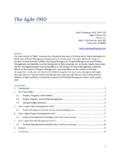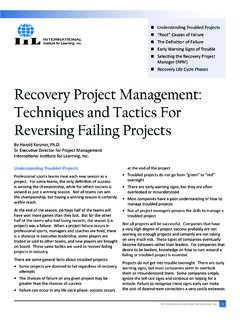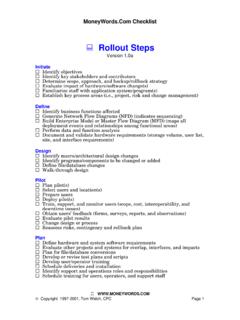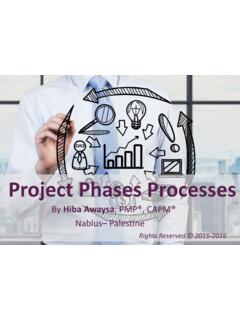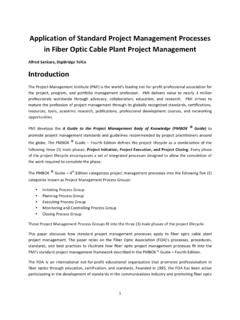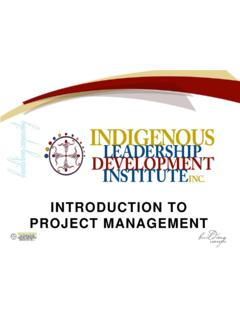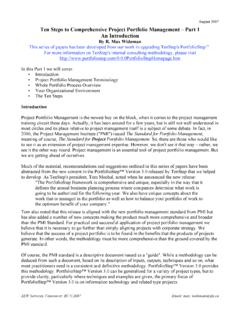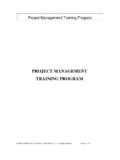Transcription of The Agile PMO - Project management
1 1 The Agile PMO Kevin Thompson, , PMP, CSP Agile Practice Lead cPrime, Inc. 4100 E. Third Avenue, Suite 205 Foster City, CA 94404 Abstract The development of Agile processes has introduced new ways of thinking about Project management , which impact Project management Organizations in various ways. This paper divides the range of practices commonly found in PMOs into Project management , Program management , and Portfolio management , and identifies how the introduction of Agile processes such as Scrum impacts these areas. We find that Agile processes have strong effects on the conduct of Project management , moderate effects on the conduct of Program management , and weak effects on the conduct of Portfolio management .
2 Finally, we note that that Portfolio management is more naturally aligned with Agile principles than are Program and Project management , and conclude that one effect of the growing adoption of Agile methods is to bring the perspective of Portfolio management down to the Project level. Contents 1 introduction .. 2 2 The Classic PMO .. 2 Projects, Programs, and Portfolios .. 2 Project , Program, and Portfolio management .. 3 Asking the Right Questions .. 6 3 How is Agile Project management Done? .. 6 Project - management Process Groups and Knowledge Areas .. 6 4 How is Agile Program management done? .. 11 Program- management Knowledge Areas and Process Groups .. 11 5 How is Agile Portfolio management done?
3 13 Portfolio- management Knowledge Areas and Process Groups .. 14 6 Analysis .. 15 7 Conclusion .. 16 2 1 introduction What is an Agile PMO? This question invariably comes up in large enterprises that have existing PMOs and are adopting Agile Project - management processes, such as Scrum. This paper does not attempt to prescribe how a PMO operates, as this subject is large and already well-documented. Instead, it assumes that a functioning PMO exists, and addresses the specific question of how the introduction of Agile processes changes how the PMO carries out its responsibilities. 2 The Classic PMO The acronym PMO may abbreviate Project management Office or Program management Office.
4 This dual definition hints at one of the major challenges of defining what a PMO is and how it works, namely, the lack of consistency in responsibilities and practices across organizations called PMOs. Nevertheless, common themes and practices do exist, and we will address them here. A classic PMO may have any combination of three major areas of responsibility: Project management , Program management , or Project Portfolio management . Alternatively, an organization may create separate offices called the Project management Office (PMO), Program management Office (PgMO), and Project Portfolio management Office (PPMO). We will use these more specific definitions in the following.
5 A Project management Office focuses on making projects successful, while a Program management Office focuses more on the success of programs, rather than projects. While a PMO and PgMO operate on different scales but have similar responsibilities, a Project Portfolio management Office is distinctly different, as it focuses on optimizing portfolios of projects to achieve business goals. Understanding what these different offices do requires an understanding the hierarchy of projects, programs, and portfolios. We will turn to three references from the Project management Institute (PMI) for definitions of these and related concepts throughout this document: A Guide to the Project management Body of Knowledge (PMBOK Guide), Fourth Edition (hereafter [PMBOK4]1) The Standard for Program management , Second Edition (hereafter [SProgMan2]2) The Standard for Portfolio management , Second Edition (hereafter [SPortMan2]3) Projects, Programs, and Portfolios Programs contain projects, while portfolios contain programs, projects, or a mix of both.
6 A Project is a temporary endeavor undertaken to create a unique product, service, or result. [PMBOK4] A Program is comprised of multiple related projects that are initiated during the program's life cycle and are managed in a coordinated fashion. The program manager coordinates efforts between projects but does not directly manage the individual projects. [SProgMan2] 3 A portfolio is a collection of projects or programs and other work that are grouped together to facilitate effective management of that work in order to meet strategic business objectives. The projects or programs of the portfolio may not necessarily be interdependent or directly related. [SPortMan2] Given these definitions, the management of these entities can be defined as follows: Project management is the application of knowledge, skills, tools, and techniques to Project activities to meet the Project requirements.
7 [PMBOK4] Program management is the centralized coordinated management of a program to achieve the program's strategic objectives and benefits. It involves aligning multiple projects to achieve the program goals and allows for optimized or integrated cost, schedule, and effort. [SProgMan2] Portfolio management is the coordinated management of portfolio components to achieve specific organizational objectives. [SPortMan2] Less formally, we might say that Project , Program, and Portfolio management operate at tactical, strategic, and business levels, respectively. Project management is about doing work correctly, while Portfolio management is about selecting the correct work for the business to do.
8 Program management is the layer in between, which addresses the integration of tactical work (projects) into strategic (program-level) deliverables. It should be noted that changes in business environment may result in the cancellation of projects or programs that no longer represent appropriate investments for the business. A well-functioning portfolio- management process can be expected to terminate programs or projects that are successful by their own objectives, but which have ceased to represent the best investment of the company s resources. Project , Program, and Portfolio management Table 1 summarizes key areas of interest, and how their focus changes across projects, programs, and portfolios.
9 [SportMan2] Area Projects Programs Portfolios Scope Projects have defined objectives. Scope is progressively elaborated throughout the Project life cycle. Programs have a larger scope and provide more significant benefits. Portfolios have a business scope that changes with the strategic goals of the organization. Change Project managers expect change and implement processes to keep change managed and controlled. The program manger must expect change from both inside and outside the program and be prepared to manage it. Portfolio managers continually monitor changes in the broad environment. 4 Planning Project managers progressively elaborate high-level information into detailed plans throughout the Project life cycle.
10 Program managers develop the overall program plan and create high-level plans to guide detailed planning at the component level. Portfolio managers create and maintain necessary processes and communication relative to the aggregate portfolio. management Project managers manage the Project team to meet the Project objectives. Program managers manage staff and the Project managers; they provide vision and overall leadership. Portfolio managers may manage or coordinate Portfolio management staff. Success Success is measured by product and Project quality, timeliness, budget compliance, and degree of customer satisfaction. Success is measured by the degree to which the program satisfies the needs and benefits for which it was undertaken.

